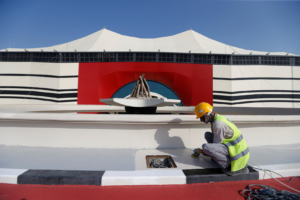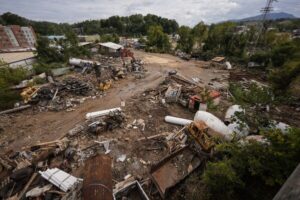A stone chest with 15 anthropomorphic sculptures and numerous beads, shells, and corals have been discovered in the heart of the ancient Aztec capital.
OVER THE YEARS, archaeologists have unearthed many offerings at the Templo Mayor, located at the heart of the ancient Aztec, or Mexica, capital of Tenochtitlán and adjacent to contemporary Mexico City’s cathedral. The most recent, the 186th to date, was announced in August: a stone chest filled with objects from the sea and 15 anthropomorphic sculptures in green stone, dating from the reign of Moctezuma Ilhuicamina (1440–69).
The discovery was made by archaeologists Alejandra Aguirre Molina and Antonio Marín Calvo, working under the direction of Juan Ruiz Hernández of the Proyecto Templo Mayor—an ongoing restoration effort focused on one of the great archaeological landmarks of ancient Mexico. It was founded by Eduardo Matos Moctezuma in 1978 not long after utility workers discovered a statue of the Aztec goddess of the moon, Coyolxauhqui, at the Templo Mayor site. The initiative is currently directed by archaeologist Leonardo López Luján.
The offering was left on a platform on the rear facade of the Huei Teocalli, to use the Nahuatl name for the Templo Mayor, a few centimeters away from an area impacted 123 years ago by the placement of a sewage pipe. The offering box includes 14 anthropomorphic male sculptures and one female figurine. This artifact dates from the time of the first Moctezuma to rule Tenochtitlán, in the middle of the 15th century.
According to the researchers, the sculptures carved from green stone exhibit characteristics of the Mezcala style from the northern highlands of the Mexican state of Guerrero, about 200 miles south of Mexico City. Among these sculptures, one that is 30 centimeters high stands out in contrast to the other figurines that are as small as 3 centimeters tall. All have some unique features, and the style of the figures and their origin in the state of Guerrero has led the archaeologists to speculate that they arrived at the Templo Mayor following the Aztec conquest of the region.
Like all Aztec rulers, Moctezuma I Ilhuicamina, whose full name in Nahuatl is Motēuczōmah īlhuihcamīna, was a powerful leader of the civilization which had its capital at Tenochtitlán. He ruled between 1440 and 1469 and was the fifth tlatoani, or ruler of Tenochtitlán. Moctezuma I expanded the territory of his empire through a series of military campaigns and conquests. During his reign, the Triple Alliance (which consisted of Tenochtitlán and the nearby cities of Texcoco and Tlacopan) succeeded in conquering several neighboring peoples and expanding its influence in the Mesoamerican region.
In addition to his military achievements, Moctezuma I is remembered for his focus on the cultural and religious development of Tenochtitlán. He promoted the construction and decoration of many temples and monuments, including the Templo Mayor, the most important ceremonial center of the Mexica civilization.
“When the Mexica subdued these peoples, the figurines were already relics, some of them are more than 1,000 years old, and presumably served as cult effigies, which the Mexica appropriated as spoils of war,” explains Luján.
Aguirre and Marín, who also worked with Sofía Benítez Villalobos, a specialist in restoring artifacts, have concluded that, after they were brought to Tenochtitlán, the sculptures underwent a ritual that transformed them and incorporated them into the religious life of Tenochtitlán. They point to traces of facial painting that the Mexica added to the figurines, associated with the god of rain, Tlaloc.
In addition to the sculptures, offering 186 included two earrings in the shape of rattlesnakes and a total of 137 beads made of various green stones, accompanied by sand and 1,942 different elements from the ocean including shells, snails, and corals.
Originally from the coasts of the Atlantic Ocean, a region subdued by the Triple Alliance in the time of the first Moctezuma, the seashells have been restored, and the responsibility for their biological identification lies with Belem Zúñiga Arellano, a member of the Proyecto Templo Mayor team.




